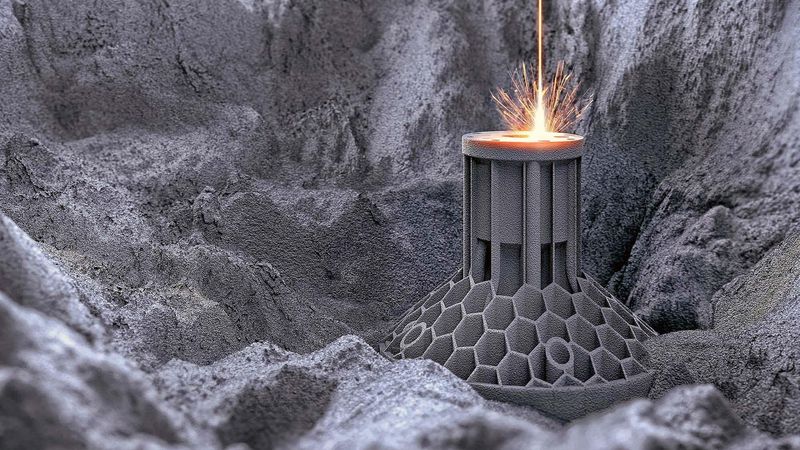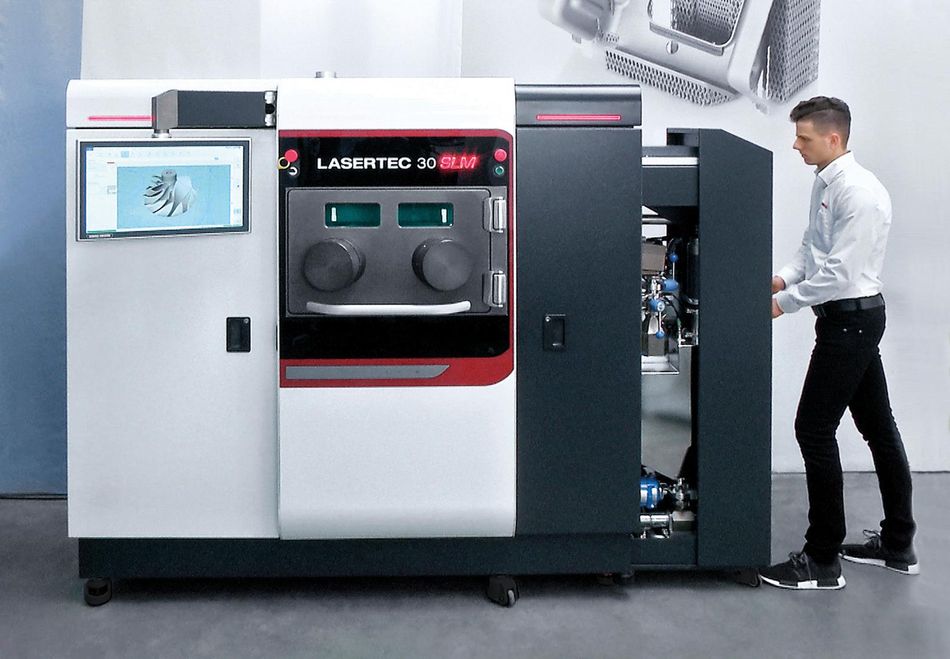Harnessing Laser Powder Bed Fusion and Automation for Unprecedented Precision and Efficiency
A deep dive into the intersection of laser powder bed fusion and advanced automation for enhanced precision, speed, and scalability.

Image credit: DMG MORI Additive GmbH
Selective Laser Melting (SLM) is a specialized additive manufacturing technique designed for the creation of metal alloy components. By utilizing a high-intensity laser beam, this method fuses powdered materials on a layer-by-layer basis, enabling the formation of intricate shapes with exceptional precision. It offers unparalleled strength, durability, and manufacturing speed while minimizing waste.
Despite its numerous advantages, SLM is an emerging technology with several critical challenges. With SLM, consistent part quality depends on the precise control and monitoring of all process parameters. The prevention of metal oxidation during manufacturing is crucial and can only be achieved through accurate control of inert gas flow in the building chamber. Full automation of the SLM process is also required for improved productivity and efficiency in large-scale production.
In the case study below, we explore how an innovative partnership overcame these challenges to deliver prints with complexity and consistency.
Utilizing automation to overcome complex challenges
DMG MORI Additive GmbH, in partnership with Festo, has made significant progress in the industrial application of SLM technology. Thanks to the automation solutions provided by Festo, DMG MORI developed LASERTEC 30 DUAL SLM, a flagship additive manufacturing system.
"Our aim is to achieve a high level of maturity of CNC machines with our additive manufacturing machines," explains Dr. Vino Suntharakumaran, Managing Director at DMG MORI Additive GmbH.
This innovative system utilizes SLM to produce highly complex components with integrated functions and internal close-contoured cooling channels, reducing product development times with the immediate availability of prototypes.
The LASERTEC 30 DUAL SLM system
In the LASERTEC 30 DUAL SLM system, two powerful 600 W lasers enable build rates of up to 90 cm³/h. The dual-laser system boosts productivity by 80%, outperforming single-laser systems. The automated powder module, rePLUG, ensures quick material change and improved efficiency. Additionally, a permanent filter system, independent of material type, enhances occupational safety by automatically passivating metal dust.
In SLM, a reliable inert gas atmosphere with stable pressure and oxygen control is crucial. "A Festo automation solution helped us achieve a breakthrough here," says Suntharakumaran. The complete solution includes Festo's valve terminal VTUG, pinch valve VZQA, MS4 service unit, and proportional-pressure regulator VEAB. These automation solutions are optimized to manage the flow of inert gases and allow the optimization of pressure conditions while halving the cycle time.
Automation solutions
Beyond providing solutions for precise gas handling, Festo offers extensive expertise in material and movement handling. SLM requires accurate control of the laser head and build platform movements to provide consistent results. To achieve this, Festo’s portfolio includes a range of axes and slides capable of extremely precise motion. In addition, Festo’s closed-loop servo systems, such as servo drives CMMT-AS and CMMT-ST and servo motor EMMT-AS, can correct movement errors in real time.
Control of powder flow and reliable handling of production materials is also a crucial requirement for the successful implementation of SLM. Festo provides a range of ready-to-install solutions to address this necessity. These include the rotary actuator DFPD, which opens and closes material flow. For fast and efficient dosing, you can consider either the CMSX positioner or the VZQA pinch valve. The MSB6 service unit delivers the necessary air preparation for the operation of these components.
Festo's involvement also extends beyond supplying automation components: their simulation software and engineering tools have contributed to the early development and integration of automation into the machine.
"That is why it is important for us to join forces with innovative partners. Festo is such a partner for us, because, as a manufacturer of pneumatic and electric automation technology it focuses and works on future topics, as can be seen in the first pneumatic cobot, bionic grippers or the Festo AX digitalisation solution," declares Suntharakumaran.
Application areas for advanced SLM technology
SLM technology primarily finds its utility in the realms of biomedical applications, dental practices, and the aerospace industry. Within the aerospace domain, the technology facilitates the fabrication of intricate designs, bespoke components and promotes weight efficiency while maintaining robustness and longevity. The parts manufactured through SLM are commonly employed in commercial aviation and rocketry. This technique enables the production of sophisticated and unparalleled components that traditional metalworking procedures fall short of realizing.
Conclusion
DMG MORI and Festo’s success story reflects their commitment to innovation in additive manufacturing while revealing the potential of automation in the future growth of SML technology. The integration of Laser Powder Bed Fusion and advanced automation is a game-changer in the realm of additive manufacturing. The versatility of SLM technology, as demonstrated in its potential application across various industries, is a testament to its revolutionary impact. As the technology, like the LASERTEC 30 DUAL SLM, continues to innovate and evolve, additive manufacturing is set to expand its influence across design and manufacturing.
Read more about additive manufacturing solutions from Festo here.
References
[1] Yap CY, Chua CK, Dong ZL, Liu ZH, Zhang DQ, Loh LE, Sing SL. Review of selective laser melting: Materials and applications. Appl Phys Rev. 2015;2:041101. doi: 10.1063/1.4935926.
[2] Gao B, Zhao H, Peng L, Sun Z. A Review of Research Progress in Selective Laser Melting (SLM). Micromachines. 2023;14:57. doi: 10.3390/mi14010057.
[3] Khurram Munir, Arne Biesiekierski, Cuie Wen, Yuncang Li. Selective laser melting in biomedical manufacturing. In: Cuie Wen, editor. Metallic Biomaterials Processing and Medical Device Manufacturing. Woodhead Publishing, 2020. p. 235-269. doi: 10.1016/B978-0-08-102965-7.00007-2.
[4] Olakanmi EO, Cochrane RF, Dalgarno KW. A review on selective laser sintering/melting (SLS/SLM) of aluminum alloy powders: Processing, microstructure, and properties. Prog Mater Sci. 2015;74:401-477. ISSN 0079-6425. doi: 10.1016/j.pmatsci.2015.03.002.
[5] Brandt M, Sun SJ, Leary M, Feih S, Elambasseril J, Liu QC. High-Value SLM Aerospace Components: From Design to Manufacture. AMR 2013;633:135–47. https://doi.org/10.4028/www.scientific.net/amr.633.135.
[6] Cosma C, Kessler J, Gebhardt A, Campbell I, Balc N. Improving the Mechanical Strength of Dental Applications and Lattice Structures SLM Processed. Materials (Basel). 2020 Feb 18;13(4):905. doi: 10.3390/ma13040905.
[7] M. S. Korium, H. Roozbahani, M. Alizadeh, S. Perepelkina and H. Handroos, "Direct Metal Laser Sintering of Precious Metals for Jewelry Applications: Process Parameter Selection and Microstructure Analysis," in IEEE Access, vol. 9, pp. 126530-126540, 2021, doi: 10.1109/ACCESS.2021.3112479

